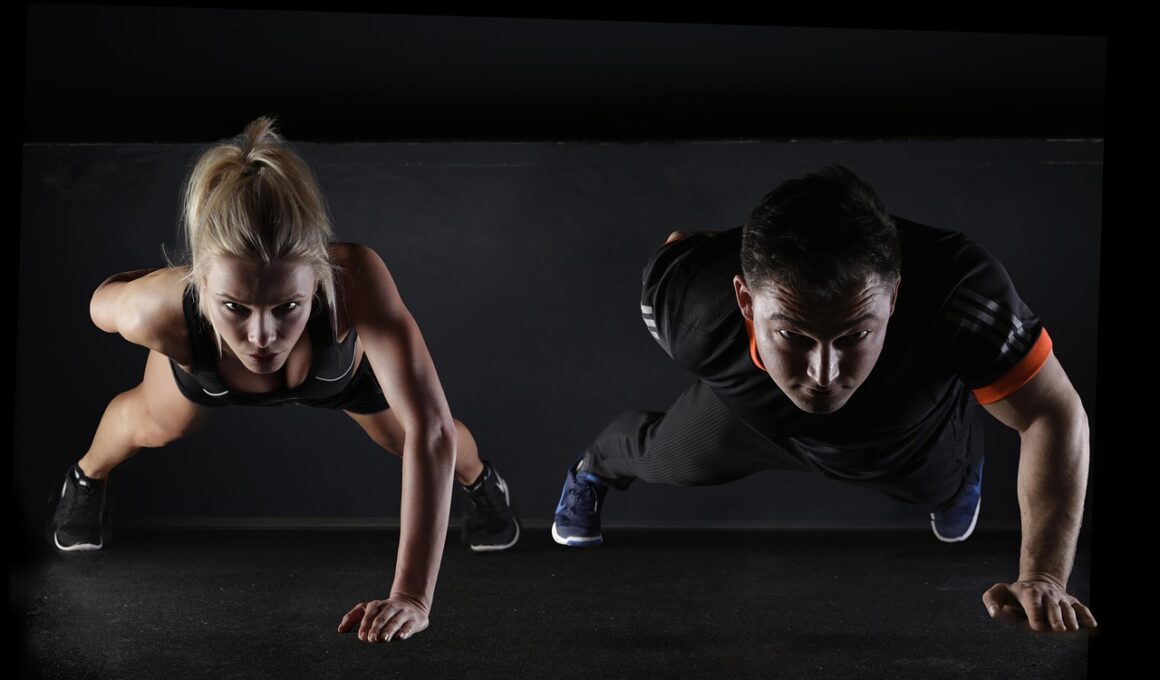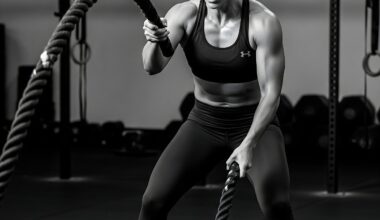Progressing Plyometric Bodyweight Exercises Safely
Plyometric bodyweight exercises are essential for developing explosive strength and improving athletic performance. However, safely progressing in these exercises requires adhering to structured methods. Understanding how to implement these strategies effectively is key to preventing injuries and promoting overall fitness. One way to enhance safety is through mastering foundational movements before introducing plyometric variations. Exercises like squats and lunges lay the groundwork for explosive movements. These foundational exercises help develop control and strength necessary for advancing to more complex plyometric exercises. Additionally, increasing core strength plays a significant role in enhanced stability during jumping movements. A strong core can absorb impact better, making plyometric exercises safer. Moreover, consider variables like height and distance when progressing. Start with small jumps and gradually increase heights and distances as you become more comfortable. Ensuring a proper warm-up and cooldown routine prepares your body for exertion and aids recovery. Implementing controlled jump landings techniques also minimizes risk. This all contributes to a more effective and safer training regimen, ensuring long-term success without the setback of injuries.
As you continue to progress in plyometric training, focusing on technique is paramount. Prioritize mastering the landing mechanics, as they significantly influence your safety and effectiveness. Each jump should exhibit a soft landing, where knees bend slightly to absorb the impact. This technique not only reduces the risk of injury but also enhances your overall performance. Moreover, incorporating strength training can greatly support your plyometric endeavors. Exercises targeting the legs, such as single-leg squats or calf raises, improve muscle power and stability, essential for explosive movements. Increasing muscle strength allows you to execute higher and more complex jumps safely. Additionally, consider integrating balance exercises into your routine. Exercises like single-leg balances or stability ball work engage core muscles and enhance proprioception, crucial for dynamic movements typical in plyometric exercises. Moreover, pay attention to your body’s feedback. If you feel any discomfort or pain during a plyometric activity, it is vital to listen and adjust your training accordingly. Creating a comprehensive progression plan that includes gradual intensity increases and adequate recovery can ensure continued progress while minimizing the risk of overuse injuries.
Incorporating Variability in Training
Another effective strategy for safe progression is incorporating variability in your training plan. This approach keeps your workouts interesting and continually challenges your body. To integrate variability, alternate between different types of plyometric exercises, such as broad jumps, box jumps, and lateral bounds. These variations target different muscle groups and help develop a more balanced physique, minimizing the risk of overuse injuries from repetitive movements. Furthermore, consider adjusting the tempo of your exercises. Slower tempo during landings can help you focus more on control, while explosive movements can be integrated gradually. Likewise, changing surfaces can also enhance your plyometric training. Practicing on softer surfaces, like grass or mats, can reduce impact stress on your joints. As you become more proficient, transitioning to harder surfaces like gym floors can add a new challenge. It’s also essential to work on recovery strategies. Adequate rest periods between plyometric sessions ensure that your muscles can repair and strengthen. Incorporating active recovery techniques such as yoga or mobility work into your regime fosters flexibility and muscle elasticity, both critical for your ongoing plyometric training success.
When progressing in plyometric bodyweight exercises, maintaining a consistent routine focused on quality over quantity is essential. Proper execution of each movement should always take precedence over the number of repetitions. One effective way to ensure this is by employing the principle of progressive overload. Gradually increase the difficulty of your exercises by modifying the height of jumps, complexity of movements, or speed of execution. This method helps in strengthening your neuromuscular connections, leading to improved muscle coordination. Consider also integrating rest days into your weekly training plan. Rest is vital for muscle recovery and growth, making it essential in preventing fatigue that can lead to poor form and injury. Regularly take stock of your training progress through journaling or progress videos. This reflection will provide insight into what works and what adjustments may be necessary. Additionally, establish clear goals that outline your desired achievements with plyometric training. Having targeted ambitions not only motivates but also puts a clear framework around your training efforts, keeping you on track as you safely progress through your plyometric bodyweight exercises.
Seeking Professional Guidance
If you’re new to plyometric training or unsure about your progression strategy, seeking professional guidance can be invaluable. A certified fitness trainer and experts in bodyweight training can help identify your strengths and weaknesses, customize your training regimen, and ensure proper technique. Working with a professional provides tailored feedback that can lead to more accelerated improvements while minimizing the risk of injury. Another consideration is utilizing technology. There are many fitness apps and wearable devices that track your performance metrics, helping you assess your training intensity and effectiveness. These tools can offer insights into areas that require adjustment and help facilitate safe progression in your plyometric exercises. In addition, group classes can provide an inspiring atmosphere and collective motivation. Many facilities offer classes focused on bodyweight and plyometric workouts, combining expert coaching with camaraderie. This social aspect can enhance accountability and foster a sense of community among participants. Engaging with others who share similar fitness goals often cultivates an invigorating environment that promotes consistency in your training routine.
Always remember to celebrate your milestones, no matter how small they may seem. Progress in bodyweight exercises, particularly when delving into plyometrics, might be gradual, but acknowledging achievements keeps you motivated. Track your performance metrics, such as jump heights and repetitions, to better understand your improvements over time. The journey into plyometric training has its challenges, and it’s essential to remain positive and focused on your long-term goals. Incorporating variations, exploring different exercises, and integrating rest days are crucial elements of progression patterns. As your skills develop, challenge yourself to refine intricate techniques, like plyometric push-ups or tuck jumps, which can enhance your agility and power. Moreover, practice mindfulness techniques to enhance psychological resilience; breathing exercises or visualization strategies can help maintain motivation and focus. Understanding that setbacks may occur is part of any training journey is important. Adaptability to these changes while remaining committed to your goals can help fortify mental strength. By implementing these strategies, you’ll be more equipped to progress through your plyometric bodyweight exercises safely while enjoying the process.
Conclusion and Future Directions
As you continue your journey in plyometric bodyweight exercises, prioritize safety alongside performance. Embracing a comprehensive strategy that incorporates all suggested techniques ensures manageable yet effective progression. Aim to balance intensity with adequate recovery, ensuring that your body remains resilient during this training. Consistency and creativity in your workout regime keep both your muscles challenged and your training session enjoyable. To further optimize results, maintain a healthy nutrition plan that complements your physical training. Proper fueling of your body aids in recovery and performance optimization while influencing your overall energy levels. Moreover, consider engaging in cross-training to boost your strength and cardiovascular endurance. Activities such as swimming or cycling provide different stimuli and focus on overall fitness. Periodically, evaluate your training approach to ensure it aligns with your evolving goals and fitness levels. Remember, the journey towards mastering plyometric exercises is ongoing, and your commitment can lead to great improvements. Invite feedback from peers or trainers as you advance to continually refine your skills. With dedication and adherence to safe progression methods, you will reach new heights in your bodyweight training endeavors.
This growing commitment to plyometric training not only enhances physical capabilities but boosts enthusiasm for fitness. Instructing others on effective plyometric techniques can also be very rewarding as you share your journey. The community aspect of fitness encourages shared learning and collective motivation. There is always something new to explore within bodyweight training, and adapting to fresh techniques will keep your routine filled with excitement. Additionally, sharing experiences and insights through various fitness platforms can inspire others, worsening awareness of safe practices during plyometric training. Make sure to document your journey, noting improvements and struggles to help others understand the process. Using social media, consider participating in fitness challenges to keep the atmosphere vibrant and engaging. Beyond personal progress, supporting others through their plyometric journeys cultivates a sense of appreciation for bodyweight training’s benefits. As you continue developing skills, remember to emphasize form and safety, which not only enhances your results but sets a strong example for others. With ongoing dedication to safe progression strategies, discovery within plyometrics continues alongside an ever-evolving commitment to fitness.


